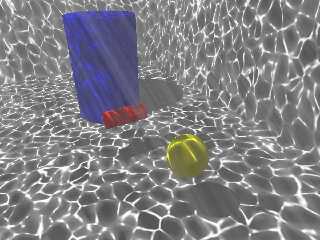|
 |
HelloI would like to extend my scene with the fake caustic to see the light rays
under water. With a scattered media this works, but the computation time
increases indisputably from 0.5 to almost 70s per frame (should become an
animation later).
In the concrete scene the samples have to be at least 50,100 for this to look
usable - so I can't turn the screw anymore.
What possibilities are there to speed up the process (I think that the
calculation time/image should not be more than double or triple, but not by a
factor of 100)?
Is there a way to fake this (similar to what I did with the caustics), but for
the scattering media I have no idea at the moment.
---------------------the scene----------------
// Testscene mit einer gefakten Caustik,
// indem eine helle light_source mit einer Kugel und entspr teiltransparenten
Textur umgeben wird
// Renderzeit: 1sek
#version 3.7;
global_settings {
assumed_gamma 1.0
}
#declare InclMedia = 1;
#declare CausAdd = 0.0;
#declare ScatterCol = 0.0004;
#include "colors.inc"
#include "textures.inc"
#declare PSize = 300;
//////// Caustics-Texture START /////////
#declare TxtS4b =
texture { // "DunkelTextur"
pigment { rgbf <1.0, 1.0, 1.0, 1*CausAdd> }
}
#declare TxtS4a1 =
texture { // "Helltextur"
pigment { color rgbf <1.0, 1.0, 1.0, 1.0> }
finish { diffuse 0.5 ambient 1 }
}
#declare TxtS4a2 =
texture {
pigment { color rgbf <1.0, 1.0, 1.0, 0.2+0.8*CausAdd> }
}
#declare TxtS4c =
bozo
scale 1.5
translate <752,74,62343>
texture_map {
[ 0.25 pigment { rgbf <1.0,1.0,1.0,0.0+CausAdd> } ]
[ 0.5 pigment { rgbf <1.0,1.0,1.0,0.1+0.9*CausAdd> } ]
[ 0.75 pigment { rgbf <1.0,1.0,1.0,0.0+CausAdd> } ]
}
//pigment { color rgbf <0.6, 0.6, 1.0, 1.0> }
}
#declare TxtS4a =
texture { // 1. Layer mit Bozo (Hell-Dunke-Effekte innerbalb der Textur)
bozo
scale 0.5
translate <1223,455,121>
texture_map {
[ 0.15 TxtS4b ]
[ 0.4 TxtS4a2 ]
[ 0.5 TxtS4a1 ]
[ 0.6 TxtS4a2 ]
[ 0.85 TxtS4b ]
}
}
#declare CausticsTxt =
texture { // die eigentliche Caustic-Textur
crackle
turbulence 0.25
omega 0
scale 5
texture_map {
[ 0.0 TxtS4a ]
[ 0.12 TxtS4c ]
[ 0.5 TxtS4b ]
}
scale 0.075
}
//////// Caustics-Texture ENDE /////////
// Boden
difference {
plane { y,0 }
box { <-PSize,-250,-PSize><PSize,1,PSize> } // Pool
pigment { Gray50 }
//pigment { bozo scale 30}
}
//#declare adsasdas =
#ifdef(InclMedia)
box { <-PSize,-250,-PSize><PSize,-50,PSize>
pigment { rgbt 1 } // clear
hollow
interior{
media{
scattering{ 1, ScatterCol extinction 0.01 }
//scattering{ 1, 0.17 extinction 0.01}
samples 50, 100 // min, max
} // end media
} // end interior
}
#end
// #declare adadas =
cylinder {
<-25,0,0><25,0,0> 10
pigment { Red }
translate <100,-200,-50>
}
cylinder {
<0,-300,0><0,100,0> 50
pigment { Blue }
translate <120,-200,70>
}
sphere {
0,20
pigment { Yellow }
translate <120,-200,-150>
}
// Sonne
light_source {
<-50,200, 0>
color 5
}
// Caustics-sphere
#declare CausticsSpr =
sphere {
0,10
texture {
CausticsTxt
translate <clock*0.02 ,clock*0.1, -clock*0.005>
}
}
object {
CausticsSpr
translate <-50,200,0>
}
#declare Cam =
camera {
location 0
direction <0.0, 0.0, 1>
up <0.0, 1.0, 0.0>
right <4/3, 0.0, 0.0>
look_at <0,0,1>
}
camera {
Cam
rotate 30*x
rotate 30*y
translate -70*y
translate -PSize*z+10
}
Post a reply to this message
Attachments:
Download 'lightsource2m1.jpg' (113 KB)
Preview of image 'lightsource2m1.jpg'

|
 |




![]()